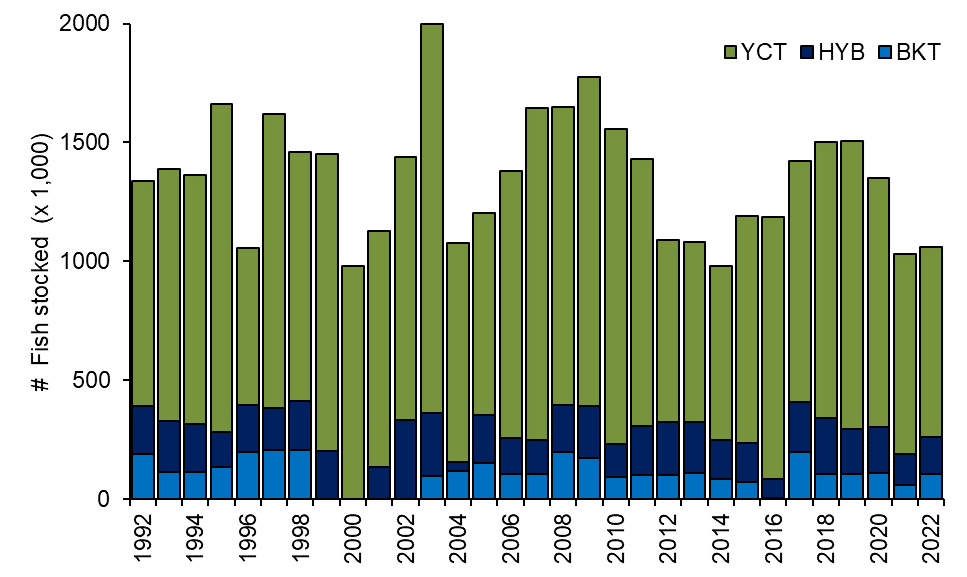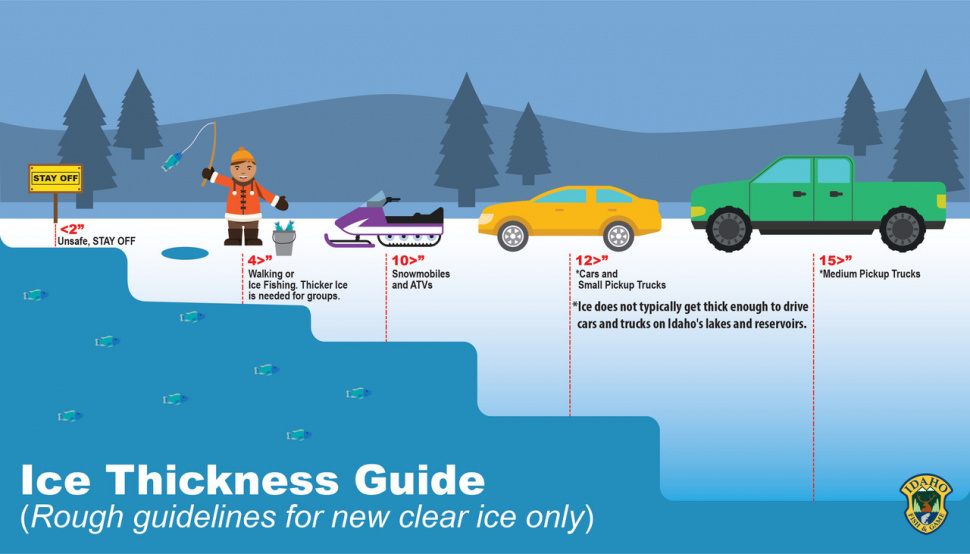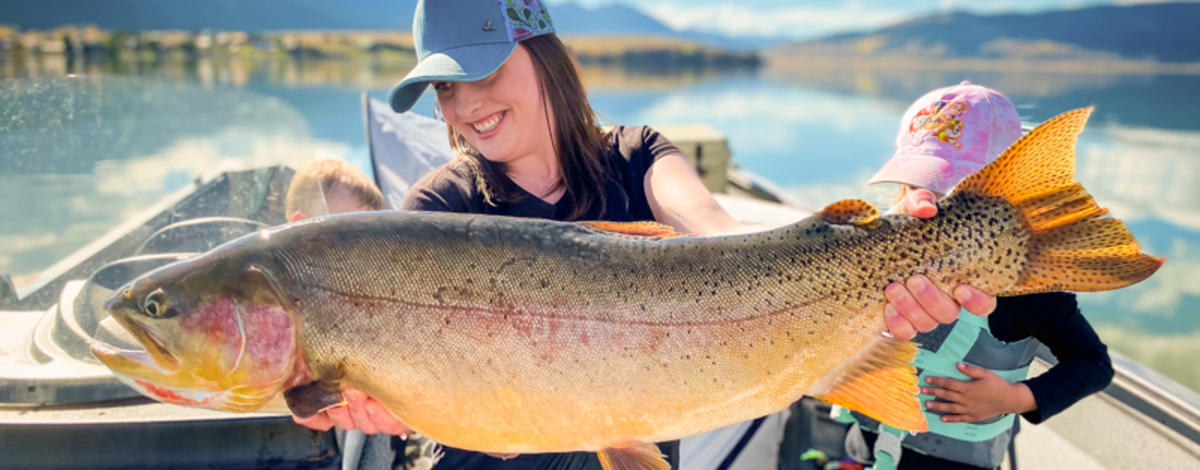
Big news Henrys Lake anglers! The new Idaho catch-and-release state record hybrid trout (Rainbow Trout X Yellowstone Cutthroat Trout) was caught out of Henrys Lake this fall, and it’s a whopper. Hailey Thomas of Rigby caught this 36-inch hybrid, which easily beats the prior catch-and-release state record by 6 inches. Based on length and girth measurements, we estimate that this fish weighed somewhere between 17-20 lbs! The best part is that this fish is still swimming around out there and growing, so we may have another record catch on our hands in the near future. Read more about Hailey’s experience catching this once-in-a-lifetime fish here.

We’ve completed our annual fish stocking efforts for the year and ended up stocking over 1 million trout into Henrys Lake in total. In June, we stocked 157,070 sterile hybrid trout. In September, we stocked 796,565 Yellowstone Cutthroat Trout and 104,160 sterile Brook Trout. Take a look at some of our historic stocking trends over the last 30 years below! Note: YCT = Yellowstone Cutthroat Trout, HYB = hybrid trout (Rainbow Trout X Yellowstone Cutthroat Trout), and BKT = Brook Trout.

In other news, we have expanded the Henrys Lake Hatchery public parking lot by approximately 40% to accommodate increased use. This will certainly benefit open water anglers during the uptick in fishing pressure that we observe in the spring and fall, but ice fisherman will see the greatest benefit since many other lake access sites are not plowed/maintained throughout the winter.


With this recent cold snap, the lake is completely frozen over and ice season is here! We’re seeing about 4-5" of ice around the shoreline in most places. Fishing is typically very good during the early ice season and it can be tempting to try to be the first ones to a new spot. We ask that anglers exercise extreme caution when venturing out onto the ice this year, as spring and stream inputs can make ice conditions variable. Just because there is safe ice in one place, does not mean it will be safe everywhere! Carry a spud bar, check ice depth often, and don’t push your luck. Read more about ice safety here.

Current and Upcoming Projects
Electric Fences: Back in June, we installed miles of electric fence along the riparian areas of several of the Henrys Lake tributaries (Howard Creek, Targhee Creek, Duck Creek, and Kelly Creek). These fences protect the stream and riparian areas from habitat degradation. Throughout the summer, our IDFG Henrys Lake seasonal crew continually maintains these fences to ensure they remain “hot” while livestock are in the area. Now that the cattle have been moved elsewhere, we have taken down the fences for the winter to allow wildlife to freely move around the lake and tributaries.
Henrys Lake Tributary Surveys: Natural reproduction of native Yellowstone Cutthroat Trout in the Henrys Lake tributaries has been low in recent years. In order to learn more about trout production in Henrys Lake tributaries, IDFG is increasing our monitoring and conducting in-depth habitat surveys to learn more about the relative quantity and quality of spawning habitat. In the fall, we conducted backpack electrofishing surveys to assess fish communities and collected genetic samples from Yellowstone Cutthroat Trout to determine if fry captured in tributaries were of wild or hatchery parental origin.
Year-long and Memorial Weekend Creel Survey: We’ve put a lot of effort into conducting a year-long creel survey in 2022, and there are only a couple of months left! Each week, myself, technicians, and/or volunteers are out interviewing anglers so we can learn more about catch rates, harvest rates, fish sizes that are caught, and much more. We also conducted creel surveys both days of Memorial Day weekend (the harvest season opener). It was quite cold, but the fishing was excellent! Stay tuned for an in-depth dive into what all we found after the year-long survey ends!
Winter Dissolved Oxygen Monitoring: Each winter, IDFG staff monitors dissolved oxygen levels under the ice to assess the likelihood of winter fish kill events. Oxygen levels start out high during the early ice season, but decline through the winter as the amount of snow/ice increases and inhibits light from passing through to facilitate photosynthesis. These oxygen surveys begin as soon as the ice is safe enough to walk on, and last until the ice is unsafe.

Ask a Biologist
At the end of each newsletter, I like to have an “Ask a Biologist” section where I can help answer/explain a timely and important question I receive about Henrys Lake or the surrounding watershed. Please send me any relevant questions you may have! My email is Nathan.Tillotson@idfg.idaho.gov.
Question:
What’s the deal with the blue-green algae blooms (AKA: harmful algal blooms or cyanobacteria blooms) in Henrys Lake?
Answer:
Back in late September, I reported a possible harmful algal bloom (HAB) to the Idaho Department of Environmental Quality (IDEQ), who promptly came out and tested the water in Henrys Lake. They confirmed the presence of cyanotoxins and anatoxins above the accepted threshold and issued a health advisory. The last water test performed on October 31 did not detect any toxins, but there must be an additional test performed with a clean result before the health advisory can be lifted.
Henrys Lake is an extremely productive system that is full of nutrients. That is one of the reasons why it can sustain such incredible populations of quality and trophy-sized trout! However, that also means that HABs can happen more easily whenever water temperatures are high for extended periods of time. Exposure to HABs can result in a wide array of symptoms (ranging from mild skin irritation to death) depending on and individual’s susceptibility and level of exposure (i.e. whether or not you just touched the water or drank/inhaled it). Dogs and children can be more susceptible to the effects of HABs, so it is best to keep them out of the water altogether when blooms are present. IDEQ has advised that fish are still safe to eat, but cyanotoxins can concentrate in fish skin, organs, and fat, so it is best to not consume those parts while the health advisory is in effect and rinse your filets thoroughly with clean water. Read more about HABs and fishing here.
These HABs (which are actually microscopic bacteria instead of true algae) are becoming nearly yearly occurrences at Henrys Lake, and likely something we are going to have to live with for a while. Fortunately, we don’t have to worry about them for much of the year! Late summer and early fall seem to be the most common times to encounter HABs on Henrys Lake. If you have any further questions about HABs on Henrys Lake, don’t hesitate to reach out to me (Nathan.Tillotson@idfg.idaho.gov) or IDEQ. If you wish to report a suspected HAB in Idaho, you can do so here.


